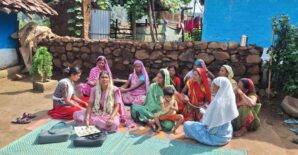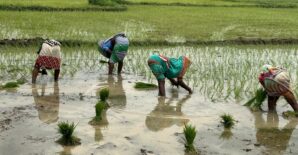New research from a Special Issue of Applied Economic Perspectives and Policy
The World Health Organization (WHO) recently declared the end of the COVID-19 pandemic as a global public health emergency, but it will be a while before we forget the upheaval it caused in the early months of 2020 and how it drove our lives to an almost complete standstill. Among other (far more serious) consequences, researchers in fields that relied heavily on primary data collection—including some of us—suddenly faced the prospect of not being able to do the work they loved.
The early days of the pandemic saw many of us drifting without purpose. We dealt with the logistics and complications of canceling our in-person data collection activities, some poised to start, others already in the field. We sought solace in the “silver lining”—more time to work on all that research that had been pending for many months! We swiftly learnt how to master Zoom and pivoted to online presentations instead of having to travel for meetings.
After the first few weeks of adjustment, however, two things became apparent. First, the impacts of the pandemic were worse and more far-reaching than we had imagined, and state-led efforts to provide relief were falling short in many places around the world. Second, we were all itching to get back to active research.
Very early into the pandemic, we, along with many others, began working on alternative approaches to our work. Some of us used existing secondary data to analyze questions of interest. Some built models that could provide predictions about hypothetical future scenarios to help guide policymaking for public health and economic welfare. And still others repurposed prior surveys of various populations to generate phone-survey data that could provide insight into the impacts of the pandemic.
Despite the large number of studies assessing the impacts of the pandemic, we felt two key things were missing. First, longer-term studies were uncommon, and as a result, we knew less about the trajectories of recovery in different countries. Second, we thought it would be valuable to focus on South Asia, home to a quarter of the global population, a region whose diverse country-level experiences could offer lessons for the developing world at large. This Special Issue was conceptualized to fill these two gaps.
The process
In January 2022, we solicited papers through an open call for extended abstracts focused on South Asia, and with an explicit request for rigorous analyses that could provide forward-looking policy-relevant lessons. We received over 40 submissions. Perhaps unsurprisingly, these were heavily skewed towards India and Bangladesh, with a smattering of papers from Nepal, Sri Lanka, Myanmar, and Pakistan, and none at all from Afghanistan and the Maldives. The bulk of submissions focused on agricultural and labor markets as well as social protection, with fewer on macroeconomic issues or regional trade.
Twenty submissions were shortlisted by the editors, and the authors were invited to submit full papers, which then underwent two rounds of reviews according to the journal’s double-blind review process. After the first round of reviews, we brought authors of the shortlisted papers together for a two-day retreat in Kathmandu. The retreat offered a space for authors to present their work and engage deeply with the feedback from reviewers and participants; it also gave the editors an opportunity to take a step back, assess shared patterns and conflicting findings across countries, and reflect on the key emerging lessons. The diversity of authors who gathered—in terms of gender, place of origin, and professional experience—offered a unique opportunity to exchange viewpoints and learn from one another. After all, it isn’t often that economic modelers and survey-based researchers actively engage with each other’s work!
Ultimately 14 papers made it to the Special Issue after the review process. Although we could not cover all the themes and countries we had hoped for, the papers included in this issue use a wide range of methodologies and asked a diverse set of questions, making for a rich collection. Four papers use modeling approaches to predict consequences for growth and distribution, analyze sectoral impacts and anticipate impacts on different types of households and enterprises; one makes creative use of migration data to estimate the spatial risks from COVID-19. Several papers re-interview respondents from previous surveys, often over the phone, and document impacts on hunger, poverty, incomes, and resilience for multiple sub-populations, including adolescents and participants in key agricultural value chains. Other papers make use of existing secondary datasets. Where feasible, non-experimental causal identification techniques allowed researchers to uncover the impacts of the pandemic on a range of outcomes of interest.
Five key lessons
We draw five key lessons from the collection of papers in this Special Issue.
- Approaches that help individuals, households, and enterprises tide over idiosyncratic shocks, or shocks affecting an individual or a small group of individuals, may fail to protect them in the face of covariate shocks, that is, shocks affecting many people simultaneously. However, building household resilience can stand them in good stead.
- Recovery is faster when the quality of infrastructure is better and when public and private institutions are robust. This includes state capacity to roll out and administer safety nets on short notice.
- Social safety nets were indispensable even if they fell somewhat short of fully mitigating the economic impacts of the pandemic.
- The ability of governments to administer large-scale social protection programs matters, but without active attention to social inclusion there is a risk that relief may accentuate and aggravate pre-existing inequalities.
- Multiple simultaneous crises can compound impacts and greatly complicate matters for policymakers. In South Asia, Sri Lanka faced a massive macroeconomic crisis, Myanmar witnessed a military coup, and Pakistan found itself in a governance gridlock that prevented the state from acting—all three unforeseen events that had serious humanitarian consequences.
A way forward
This Special Issue offers new insights from one of the most populous regions in the world and enables us to draw clear, forward-looking suggestions for policy. A key actionable finding is that investments in data collection are crucial. Another is that building up both the physical and institutional infrastructure of value chains (their “bones” and “blood”) is needed to make food systems resilient to shocks. Investing in state capacity to design and implement social protection programs seems to have high returns. Finally, there is a clear need to create and nurture opportunities for regional learning and cooperation. Such regional cooperation can help countries that face multiple crises and have limited financial or state capacity to overcome overwhelming challenges. It can also help build robust systems for supporting transnational or internal migrants, promoting regional trade, and coordinating national and regional policy that can minimize the collective impact of shocks.
As we look to a future with more frequent covariate shocks, let’s resolve not to be caught off guard again and instead invest in robust inclusive strategies to minimize disruptive impacts.
Kalyani Raghunathan is a Research Fellow with IFPRI's Poverty, Gender, and Inclusion Unit based in New Delihi. Cited research is peer-reviewed. In early 2022, Sudha Narayanan, Shahidur Rashid, and Kalyani Raghunathan (IFPRI), and Alex Winter-Nelson (University of Illinois) began pulling together a Special Issue for the journal Applied Economic Perspectives and Policy focused on COVID-19 in South Asia. Their goal was to distill forward-looking lessons for the developing world by drawing on similar and disparate country-level experiences. The issue is now available online and its 14 papers provide important lessons for future shocks.
This blogpost first appeared on the IFPRI website.



